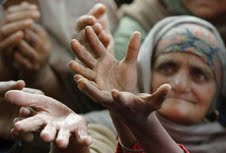Shimla: Rising food prices and a state scheme of doling out subsidized food items to all ration card holders in the state is expected to exceed budgetary provisions for 2011-12 by as much as 35 percent even as the scheme has cost the state exchequer Rs 474 crore in three years.
Food and civil supply minister Ramesh Dhawala let the Vidhan Sabha know today that Rs 86.16 crore had been spent under the state food subsidy scheme in the current financial year.
Though a budget provision of Rs 100 Cr had been made for supplying 3 Kgs of pulses, 1 liter of cooking oil and 1 Kg of salt to 16,31,804 ration card holders registered in the state, the final bill was likely to touch Rs 135 crore for the year, the minister said.
With there being 5,14,000 cards categorized as below poverty line (BPL) families, of which 1,97,100 belong to the poorest of poor (Antodaya) group and the remaining 11,17,804 belonged to above poverty line category, he disclosed.
With the state launching a separate food subsidy scheme of its own in 2007to provide relief from rising food prices in addition to the central sponsored public distribution scheme (PDS), there has been a phenomenal rise in number of ration card holders in the last 3 years as the schemes provides food items on card basis an not per head basis.
Data laid in the house showed that between 1st April, 2009 and 1st March, 2012 number of card holders increased from 15,58,093 to 16,31,804 adding 73,711 family ration cards in the period.
Referring to the 2011 census data, the minister said that whereas the census has put the states population at 68.5 lakhs but the number of existing cards project a population of over 74 lakhs and the central government PDS scheme only supplies essential items such as wheat flour, rice, sugar and kerosene oil for a 60 lakh population (2001 census), causing a shortfall.
“The central government has cut our quota of rationed food items under PDS,” says Dhawala.
Rising food prices and a state scheme of doling out subsidized food items to all ration card holders in the state is expected to exceed budgetary provisions for 2011-12 by as much as 35 percent even as the scheme has cost the state exchequer Rs 474 crore in three years.
Food and civil supply minister Ramesh Dhawala let the Vidhan Sabha know on Friday that Rs 86.16 crore had been spent under the state food subsidy scheme in the current financial year.
Though a budget provision of Rs 100 Cr had been made for supplying 3 Kgs of pulses, 1 liter of cooking oil and 1 Kg of salt to 16,31,804 ration card holders registered in the state, the final bill was likely to touch Rs 135 crore for the year, the minister said.
With there being 5,14,000 cards categorized as below poverty line (BPL) families, of which 1,97,100 belong to the poorest of poor (Antodaya) group and the remaining 11,17,804 belonged to above poverty line category, he disclosed.
With the state launching a separate food subsidy scheme of its own in 2007 to provide relief from rising food prices in addition to the central sponsored public distribution scheme (PDS), there has been a phenomenal rise in number of ration card holders in the last 3 years as the schemes provides food items on card basis an not per head basis.
In four years Rs 434 crore has been spent from the state budget on subsidized rations of which Rs 115.52 Cr was spent in 2009-10 and Rs 80.69 Cr in 2010-11, the minister said.
Data laid in the house showed that between 1st April, 2009 and 1st March, 2012 number of card holders increased from 15,58,093 to 16,31,804 adding 73,711 family ration cards in the period.
Referring to the 2011census data, the minister said that whereas the census has put the states population at 68.5 lakhs but the number of existing cards project a population of over 74 lakhs and the central government PDS scheme only supplies essential items such as wheat flour, rice, sugar and kerosene oil for a population of 60 lakhs, causing a shortfall in the demand.
“The central government has cut our quota which we have been agitating,” says Dhawala.
With the center fixing the state sugar quota at 47,000 quintals, it was being disbursed at 600 gms per head instead of the entitled 700 gms under PDS. The rice quota was reduced to 7118 tons and that of wheat was 9490 tons, whereas the quota of kerosene oil had been reduced from 54.11 Kiloliter to just 25.76 kl, the minister said.
The modus operandi to corner larger share of rations is to record a joint family as a nuclear one. To avert such pilferages the government intervened and introduced family size slabs as entitlement for food items.
With larger families being entitled for more food and those adhering to family planning norms being at the receiving end by getting lesser food, the scheme is ironically skewed in favour of larger families.
A government drive to check fake or duplicate ration cards has so far stumbled upon 6787 such cards that stand cancelled. “Even FIRs against some such law offenders have been registered,” said Dhawala.
As Editor, Ravinder Makhaik leads the team of media professionals at Hill Post.
In a career spanning over two decades through all formats of journalism in Electronic, Print and Online Media, he brings with him enough experience to steer this platform. He lives in Shimla.





